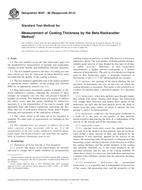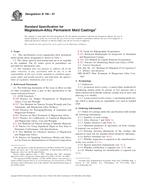1.1 This specification delineates procedural requirements for exhibits and expositions for meetings, events, trade shows, or conferences (hereafter, referred to as events). This includes the set up and dismantling of trade shows and the exhibits that are built within the event floor.
1.2 This specification identifies environmental sustainability criteria to be included in exhibits and expositions by planners, general service contractors, exhibitors, exhibit builders, and exhibitor-appointed contractors.
1.3 There are nine specifications covering the following areas of event planning: destination selection, accommodations, food and beverage, audio visual, onsite offices, communication and marketing materials, transportation, exhibits, and venues. Within each specification are eight categories' criteria: staff management policy, communications, waste management, energy, air quality, water, procurement, and community partners. Each category is further split into four progressive levels of achievement. Information within each specification is divided as follows: Main Body-Scope, Referenced Documents, Terminology, Planner Requirements for Level 1, Supplier Requirements for Level 1, and Keywords; Annexes-Planner Requirements for Levels 2 – 4, and Supplier Requirements for Levels 2 – 4.
1.4 All areas of performance under this specification may not be relevant for each event or for each facility or provider of meting services. In some cases, an event planner would use this specification in conjunction with other specifications (for example, Specifications , ) or this specification may be used individually. In other words, elements of an event may be separated and considered solely or added together and considered as a unit (for example, venues used individually versus transportation, accommodations, and destination selection used in conjunction). Furthermore, this specification applies separately to each supplier for an event. This means that if multiple suppliers are used within the context of a single specification, each supplier shall individually meet the supplier requirements. In cases, where it is incumbent upon planners to consider the activities and responsibilities of all suppliers for an event, not only the primary suppliers addressed in this specification, the term event supplier shall be used. The requirements for suppliers do not apply to event suppliers. To be considered an environmentally sustainable event at Level 1, all areas applicable to that event shall be achieved.
1.5 If higher levels are achieved in some sections, the event can only be considered environmentally sustainable at the lowest level achieved.
1.6 The use of levels within this specification recognizes that the path to environmentally sustainable events is a multi-stage effort. The idea behind the levels is to provide a coherent baseline for measuring environmental performance, to be flexible enough to adapt to the needs of more advanced planners and to establish a performance path that encourages further environmental performance improvement. In addition, the evolution of products and services to support events is expected allowing additional advancements and underscoring the dynamic nature of environmental sustainability. This specification primarily focuses on environmental sustainability, while some aspects of economic and social sustainability are included recognizing the complete path toward overall sustainability.
1.7 This standard does not purport to address all of the safety concerns, if any, associated with its use. It is the responsibility of the user of this standard to establish appropriate safety and health practices and determine the applicability of regulatory limitations prior to use.
Product Details
- Published:
- 08/15/2011
- Number of Pages:
- 9
- File Size:
- 1 file , 97 KB


